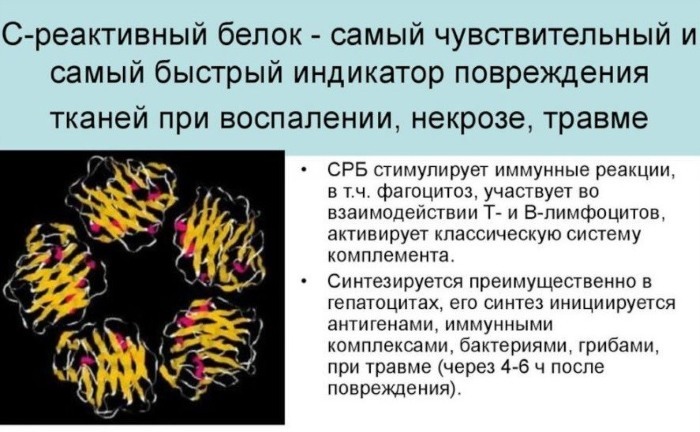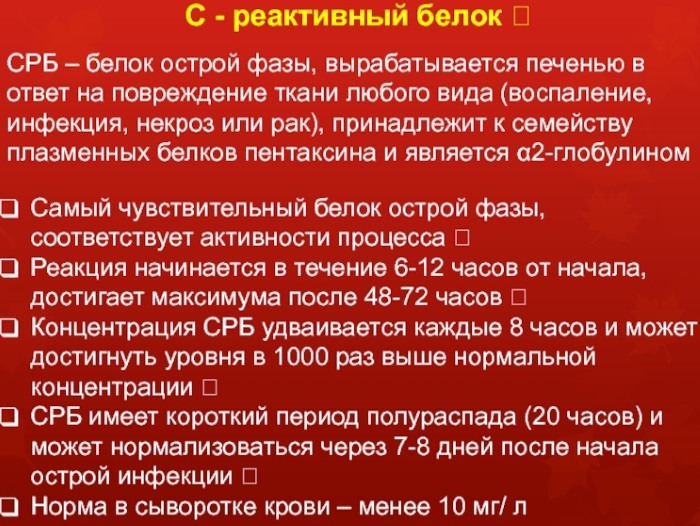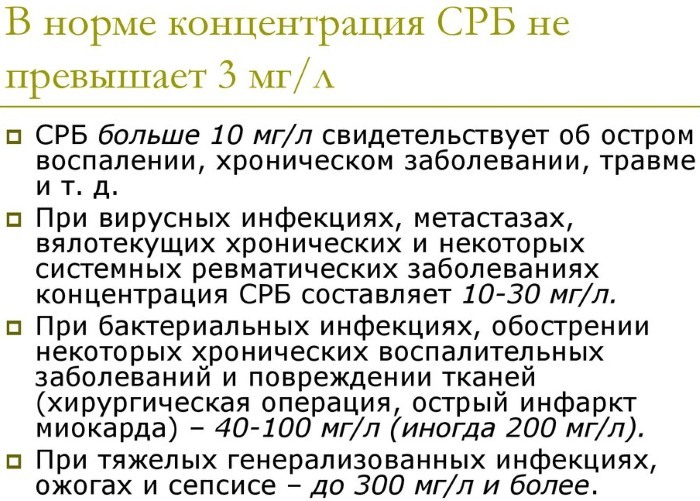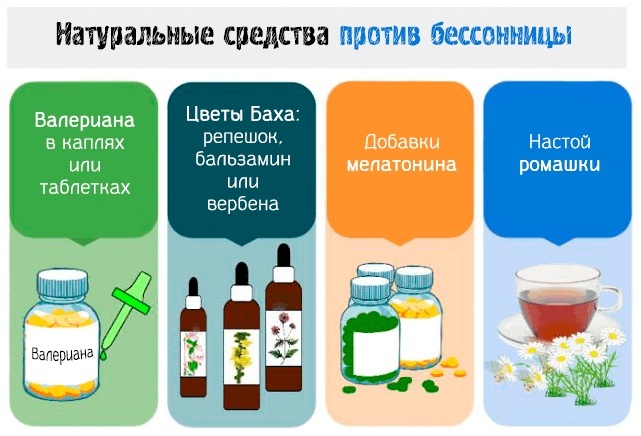Content
- What is C-reactive protein and what is it responsible for in the body?
- The rate of CRP in the blood of an adult, a child
- Reasons for an increase in C-reactive protein
- Possible diseases
- Causes in men
- Causes in women
- Causes in children
- Symptoms
- Diagnostics
- Preparation for analysis
- Conducting research
- Decoding the results
- Assessment of the risk of heart attack by CRP
- CRP and osteoporosis
- C-protein and pregnancy
- Infections
- Autoimmune diseases
- Heart diseases
- Hepatitis
- Cirrhosis of the liver
- Gastritis
- Stomach ulcer
- How informative is the analysis for chronic diseases?
- What to do and how to treat elevated C-reactive protein?
- Video about CRP in the blood
Level up C-reactive protein in the blood plasma of an adult or a child of any age group indicates the presence of an acute or chronic disease associated with the development of an inflammatory process. The main reasons for the increase in the concentration of CRP are infectious and parasitic invasions, accompanied by damage to tissues of internal organs and structural elements of the musculoskeletal apparatus.
What is C-reactive protein and what is it responsible for in the body?
CRP (C-reactive protein) is a glycoprotein of the human body, which belongs to the protein group of substances, the active increase of which occurs due to the development of increasing tissue inflammation. The more severe the pathological process that disrupts the work of internal organs or restricts the functional mobility of the muscular system, the higher the concentration of CRP in the blood.
In adult men and women, C-reactive protein values begin to increase rapidly after infection with bacterial, viral or fungal microorganisms that can cause acute inflammation. In children, a high level of CRP may be present even in the presence of an infectious focus with a chronic form of the course.
The synthesis of C-reactive protein is carried out by the liver tissues as the body's immune response increases in response to an infectious invasion. Under the influence of cytokines that carry out an anti-inflammatory function, the process of active the production of CRP, the increased concentration of which is observed already after 6 hours from the onset of the development of the acute phase diseases.
After 24 hours, the C-reactive protein index in the patient's blood plasma can be increased by 10 times, depending on the functional state of the cells of the immune system. After 2 days from the onset of the development of the acute phase of the inflammatory process, the level of CRP exceeds the norm by 100 times. A similar clinical picture indicates the negative dynamics of the progression of an infectious disease.
CRP in the blood is increased in an adult (the reasons for the deviation from the norm are determined by the results of a diagnostic examination), the body of which is infected with pathogenic microflora. Clinical studies show that the highest C-reactive protein values are observed after the onset of acute inflammation caused by a bacterial infection.
In most cases, CRP levels exceed 100 mg per liter of venous blood. In patients infected with viral microorganisms, the concentration of C-reactive protein almost never exceeds 20 mg. The increase in the level of CRP in the blood is influenced not only by the presence of pathogenic microflora, but also by severe pathologies of the cardiovascular system, tumor and necrotic processes.
The rate of CRP in the blood of an adult, a child
The table below shows the reference values of the level of C-reactive protein in adults and children, which indicate the absence of inflammatory and neoplastic processes.
| Age category | CRP rate |
| Adults and children | 0 to 1 mg per 1 L of venous blood |
The level of C-reactive protein below 1 mg indicates the absence of a pathological process in body, as well as an extremely low risk of developing severe complications associated with the presence of cardiovascular diseases. Adults and children with research results from 1 to 3 mg per 1 liter are automatically enrolled in a group of more than a high probability of the presence of foci of chronic inflammation, a tendency to diseases of the heart and blood vessels.
An excess of the normal values in the range from 3 to 10 mg indicates that patients have a high risk of developing complications from the cardiovascular system. If the level of C-reactive protein is higher than 10 mg per 1 liter of venous blood, then the adult and the child are assigned to re-examination, and additional diagnostics are performed to determine the focus of infection or inflammatory process.
Reasons for an increase in C-reactive protein
CRP in the blood is elevated in an adult (the reasons for the violation of normal indicators are established as soon as possible), who has acute or chronic diseases of the body. There are a large number of factors provoking a rapid increase in the level of C-reactive protein.
Possible diseases
Almost all diseases provoking an increase in the level of C-reactive protein are characterized by the presence of acute symptoms.
An increase in the concentration of CRP in the blood plasma causes the following pathological conditions of the body:
- the consequences of surgical intervention (a slight increase in the level of C-reactive protein is observed in the period of postoperative tissue recovery, but at the same time increases sharply in the case of their infection);
- all types of bacterial and viral diseases that cause an acute response of the immune system;
- osteomyelitis of bone tissue;
- malignant tumors, as well as cancer metastases that have spread to neighboring tissues and other systems of the body;
- the period of recovery of the musculoskeletal system after a body injury (severe contusion, extensive hematoma, bone fracture with displacement);
- burns of large areas of the skin;
- diseases of the human immune system, in which cells that perform a protective function attack healthy body tissues, provoke multiple foci of acute or chronic inflammation;
- bacterial blood poisoning;
- acute phase of myocardial infarction;
- tobacco smoking;
- exacerbation of infectious diseases with a chronic form of the course;
- diabetes;
- arterial hypertension (the presence of this disease requires additional diagnostics cardiovascular system, as well as monitoring the indicators of systolic and diastolic pressure).
An increase in C-reactive protein levels occurs in overweight adult men and women. At the same time, the risk of developing disorders from the organs of the cardiovascular system increases significantly. An increase in the concentration of triglycerides in the blood also provokes an increase in the concentration of CRP.
Causes in men
CRP in the blood is increased in an adult (the reasons for the increase in test results may be associated with a person's lifestyle) in a man under the influence of the following factors:
- abuse of tobacco products;
- chronic inflammation of the tissues of the prostate gland;
- the predominance in the diet of foods containing high cholesterol;
- dependence on alcoholic beverages and complications associated with their regular use.

At risk are men who do not lead a healthy lifestyle, do not monitor the quality of their diet, perform heavy physical work, accompanied by frequent injuries, bruises and sprains fabrics.
Causes in women
An increase in C-reactive protein in women occurs for the same reasons that were described in the sections above. At the same time, the balance of sex hormones affects the increase in the concentration of CRP. Women with increased levels of progesterone and estrogen have higher levels of C-reactive protein. The presence of chronic or acute inflammation in the organs of the female reproductive system also provokes an increase in CRP.
Causes in children
In most cases, an increase in C-reactive protein indicators in children is associated with the influence of the following pathological factors:
- sinusitis;
- chronic tonsillitis;
- adenoids;
- sinusitis,
- allergic reactions of the body;
- bruises and other injuries of the musculoskeletal system received during falls;
- period of teething;
- frontal.

The child's body is more vulnerable to the effects of bacterial and viral infections, since it has not yet strengthened the immune system. Therefore, in a child, an increase in the level of C-reactive protein can occur even in the presence of a chronic focus of bacterial infection.
Symptoms
CRP in the blood is increased in an adult (the causes of the disease are determined using a comprehensive diagnosis), the immune system of which has failed to cope with the infectious invasion. An increase in the concentration of CRP in the blood plasma is manifested by the presence of concomitant symptoms characteristic of a particular disease, which provoked the growth of C-reactive protein.
In this case, the patient has the following symptoms:
- feverish condition;
- a sharp increase in body temperature, which reaches 38-39 degrees Celsius, continues to rise and is very difficult to get off with drugs;
- physical weakness and fatigue;
- dizziness;
- nausea and vomiting;
- loss of appetite;
- the release of cold sweat in a room where a comfortable air temperature prevails;
- redness and swelling of tissues in the area of development of the inflammatory process;
- headache;
- extensive intoxication of the body;
- loss of consciousness.
The severity of the pathological symptoms depends on the underlying disease, which is causing the rapid rise in C-reactive protein. Qualified treatment of the underlying pathology allows to stabilize the general condition of the patient, to reduce the severity of the inflammatory process.
Diagnostics
To determine the parameters of C-reactive protein, a laboratory study of venous blood is performed. To perform this analysis, it is enough from 5 to 10 ml of biological material. Blood sampling is carried out under sterile conditions in the manipulation room. The selection of biological material is performed from the cavity of the ulnar vein. To carry out this diagnosis, a laboratory method of immunoturbidimetry is used.
To carry out this diagnosis, a laboratory method of immunoturbidimetry is used.
Preparation for analysis
Preparation for a blood test for the level of C-reactive protein requires adherence to the following preparation rules:
- The last meal should take place no later than 12 hours before the visit to the diagnostic center.
- In 30 min. before blood sampling, emotional and physical stress must be completely excluded.
- The last cigarette must be smoked no later than half an hour before visiting the clinic.
Blood for the indicator of C-reactive protein is donated in the morning from 08-00 to 10-00 on an empty stomach. Compliance with these recommendations will allow you to get the most reliable results of laboratory diagnostics.
Conducting research
To determine the level of C-reactive protein in the composition of venous blood, a laboratory test method called immunoturbidimetry is used. Biological material obtained from the cubital vein is sent for further analysis.
The average duration of the study is 1-2 working days, depending on the workload of the diagnostic center and its material and technical base. The cost of a blood test for the level of C-reactive protein starts at 550 rubles.
Decoding the results
A hematologist, infectious disease specialist, virologist or therapist is involved in decoding the results of a blood test for CRP. In patients with pathologies of the cardiovascular system, a cardiologist examines the laboratory report on the concentration of C-reactive protein.
Assessment of the risk of heart attack by CRP
The risk of developing myocardial infarction, as well as other serious diseases of the cardiovascular system is considered high if, after a laboratory blood test, a result was obtained in the range from 3 to 10 mg per 1 liter venous blood. Such a medical opinion indicates the possible presence of hidden pathologies of the heart and blood vessels, the exacerbation of which can occur under the influence of negative factors.
For example, in the case of gaining additional body weight, smoking, after drinking alcohol or intense physical activity. People in the high-risk group require additional examination using hardware diagnostic methods (ECG, MRI, ultrasound of the heart and blood vessels).
CRP and osteoporosis
Secondary osteoporosis is a disease of the body that can develop under the influence of chronic inflammation. Patients with the first signs of bone demineralization undergo a comprehensive examination, including indicators of C-reactive protein.
An increase in the concentration of this protein is possible in patients with primary osteoporosis, in whose bones there are small cracks formed against the background of a gradual decrease in the body's mineralization with salts calcium and phosphorus. Such pathologies of the musculoskeletal system can cause local inflammation, which provokes an increase in CRP indicators.
C-protein and pregnancy
In women who are in a state of pregnancy, a slight increase in C-reactive protein values is observed in the 1st trimester of fetal formation. The emergence of such research results is a physiological reaction of the body to the presence of an embryo, which in the first 3 months. its development is perceived by the female body as a foreign object.
Pregnancy is the factor that can skew CRP laboratory results upward. For example, if a woman takes this analysis, but does not yet know about her situation.
Infections
Infection of the body with bacterial and viral infections is one of the most common causes of the development of acute inflammation, which is accompanied by a rapid increase in the level of C-reactive squirrel.
The more extensive the insemination of body tissues with pathogens, the more acute is the reaction of the immune system, followed by an active increase in CRP. The highest level of C-reactive protein is observed in patients with signs of tissue necrosis and sepsis. In this case, a real threat of death is created.
Autoimmune diseases
Autoimmune diseases provoke an acute inflammatory process of muscle tissue, internal organs and joints of the musculoskeletal system. In the presence of pathologies of this type, C-reactive protein values always exceed the level of 10 mg per 1 liter of venous blood, and the further increase in its concentration depends on the type of autoimmune disease.
The severity of the inflammatory process is influenced by which organs and tissues were the target of the own cells of the human immune system. This cause of elevated C-reactive protein levels is considered the most difficult to diagnose.
Heart diseases
An increased level of C-reactive protein leads to the binding of lipids with low molecular density, the development of sluggish inflammation in the inner epithelial layer of blood vessels. Over time, this becomes the cause of severe heart disease in the form of angina pectoris, acute myocardial infarction, coronary artery disease, atherosclerosis.
A cardiologist performs a transcript of a laboratory blood test. If, according to the results of diagnostics, an indicator is established from 1 to 3 mg of CRP, then this patient already needs an organ examination cardiovascular system, since there is a certain proportion of the risk of developing complications in the work of the heart muscle and blood vessels.
Hepatitis
CRP is a glycoprotein, the optimal concentration of which depends on the functional state of the liver. The presence of acute or chronic diseases of this organ is accompanied by an inflammatory process. Hepatitis and other liver diseases cause an increase in the level of C-reactive protein. In most cases, this figure does not exceed 20 mg per 1 liter of venous blood.
During the period of remission of viral hepatitis, the test result can be in the range of 10-13 mg. As the disease progresses and the inflammatory process worsens in the liver, the concentration of CRP increases. During the deciphering of C-reactive protein parameters in patients with liver pathologies, that the fact that in the presence of viral infections the level of CRP is always lower than in the case of bacterial infection organism.
Cirrhosis of the liver
Cirrhosis of the liver is actually the disintegration of the tissues of a given organ, the cells of which cease to perform their previous functions, and are gradually destroyed. During this process, there is a rapid increase in the level of C-reactive protein. In the last stages of cirrhosis, CRP values can reach 100 mg per 1 L of blood, and sometimes exceed this concentration.
Gastritis
Gastritis is a chronic inflammation of the gastric mucosa, which periodically becomes aggravated. As this pathology progresses, the inflammatory process increases, along with which the concentration of C-reactive protein increases.

The CRP indicator exceeds 20 mg per 1 liter of venous blood if gastritis is of bacterial origin.
Stomach ulcer
A stomach ulcer is a severe pathology of the gastrointestinal tract, in which the walls of the digestive organ are destroyed. This process is accompanied by acute inflammation and a sharp increase in CRP levels. The concentration of C-reactive protein depends on the type of peptic ulcer disease, its nature of origin and the area of the stomach lesion.
How informative is the analysis for chronic diseases?
Analysis of the level of C-reactive protein is quite informative for the determination of chronic and acute diseases. For example, with a sluggish inflammation, which negatively affects the work of the body, functions internal organs, the result of laboratory diagnostics of blood for CRP will be an indicator from 1 to 3 mg or from 3 to 10 mg. The presence of such a conclusion indicates that there is no acute inflammation in the patient's body, but the presence of chronic foci of the pathological process is possible.
What to do and how to treat elevated C-reactive protein?
An increased level of C-reactive protein is only an indicator or one of the symptoms of an underlying disease of the body. In order for the CRP indicator to return to normal, it is necessary to treat the pathology that provoked acute or chronic tissue inflammation.
In this case, drugs of the following groups are used:
- antibiotics;
- immunosuppressants;
- non-steroidal anti-inflammatory drugs;
- chemotherapy drugs;
- antiseptics.
Methods of surgical treatment can be used to remove foci of tissue necrosis and oncological neoplasms.
An increase in the level of CRP in the blood in an adult occurs due to the presence of acute or chronic inflammation that is present in soft tissues, internal organs, structural elements of the musculoskeletal apparatus. The pathogenic activity caused by a bacterial infection provokes an increase in the concentration of C-reactive protein to a level of 100 mg per 1 liter of venous blood. Viral microorganisms cause an increase in CRP up to no more than 20 mg.
The danger of high C-reactive protein values is associated with the fact that this protein provokes inflammation of the inner layer of blood vessels. Over time, this leads to the formation of atherosclerotic plaques, an increased risk of myocardial infarction with a further onset of death.
Video about CRP in the blood
C-reactive protein is elevated in the blood. Causes:



